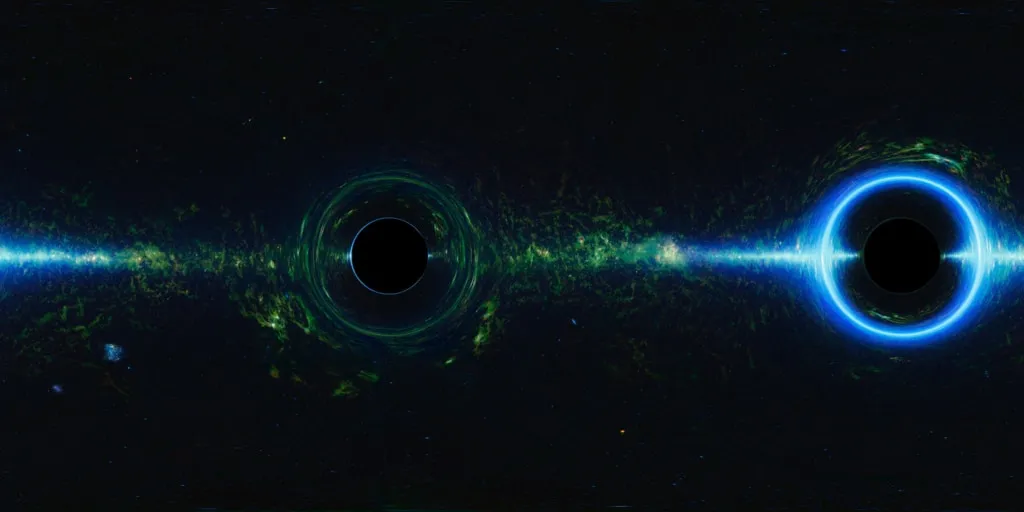Black Holes are some mysterious and enormous celestial objects that have brought about a lot of misconceptions in people’s mind. We can imagine Black Holes as a cosmic magician that plays a trick on the universe. One of the subsets of this trick is a stellar-mass black hole.

As quoted in the picture taken by NASA, “This simulated image shows how black holes bend a starry background and capture light, producing black hole silhouettes. A distinctive but hard to observe feature called a photon ring outlines the black holes.”
Stellar Mass Black Holes, like other Black holes, are objects or regions in space from which no matter can escape, not even light. Although we know some reasons why Black Holes exist, where a (stellar mass) black hole leads to is hotly debated in the scientific community. Picture a star more than 3 to 5 times more gigantic than our Sun and is in the latter stages of its life. Eventually, it gets old and runs out of fuel. In its dying phases, it explodes in a firework show called a supernova explosion and what is left behind is a small super-dense core. If the core is more than three times the mass of our Sun, then it squeezes down even more to form a Stellar-mass black hole.
Life Span and Mass of a stellar-mass black hole
Stellar-mass black holes have incredibly long-life spans in the cosmic time scale. Their mass is depleted due to a process called Hawking radiation, which Stephen Hawking predicted. (Hawking Radiation is a theory predicted by Hawking, and according to him, even black holes emit radiation, and gradually, through evaporation, they lose their masses until they vanish) However, the evaporation process is extremely slow, and their expected lifespan can be longer than the universe’s current age. Thus, many physicists call them immortal.

The first image of the Black Holes that lies at the center of the Milky Way galaxy. This Black Hole is way greater in size than a stellar mass black hole.
Stellar-mass Black holes typically have a mass ranging from about 3 to 10 times the Sun’s. Black holes whose masses are below the range of this are theoretically expected to evaporate rapidly due to Hawking radiation. As the temperature of a black hole is inversely proportional to its mass, the lesser the mass of a Black Hole, the faster it evaporates as its temperature is higher. Some of the less significant black holes combine with their nearby ones and form a larger one; black holes are primarily measured through indirect methods as direct observation of black holes is challenging due to their light-swallowing nature. Astronomers often study the motion of a star near a black hole in the Binary System to calculate its mass.
How are stellar mass Black Holes detected?
By analyzing the orbital dynamics, they can see the presence and mass of unseen black holes. The emission of X-rays from accretion around the black hole and the gravitational effect on nearby objects also provide information about its mass.

An artist’s impression of a Black Hole. How a stellar mass black hole is formed is dependent on the initial conditions of the star’s death.
Additionally, the recent detection of gravitational waves has opened a new era in black holes and astronomy. Black holes can merge to produce gravitational waves, and observing these waves in space-time can provide information about the masses of stellar-mass black holes. The groundbreaking approach developed by projects like LIGO and Virgo has offered more direct information on figuring out the masses of black holes, including stellar-mass ones.
Conclusion
The exact count of mass black holes in a universe remains certain due to the challenges of the blockages, such as the sound of the universe and the distance between the Earth and black holes. In conclusion, Stellar-mass black holes are formed by the remains of exhausted stars, and their mass ranges from 3 to 10 times the mass of our Sun. It is calculated using various indirect methods, such as calculating the binary system of the nearby stars or from x-ray acceleration around the black holes and finding out the gravitational waves emitted when two black holes collide.
Frequently Asked Questions related to Stellar Mass Black Holes
What would happen if you were to fall into a stellar-mass black hole?
As an object approaches the Event Horizon, the tidal process stretches and compresses it, causing time dilation. Once the Event Horizon is passed, the object will be infinitely strong, leading to its demise.
Can stellar-mass black holes collide, and if so, what are the consequences?
Yes, still, the mass of black holes can collide. When they merge, they create gravitational waves that propagate through space-time, providing a unique signature that can be detected by observing batteries like Lego and Virgo. These batteries give full information about most black holes, and we can even calculate their mass after a collision and before a collision.
Is there a limit to how massive a star can become before forming a black hole?
Stars with masses around 20 times our Sun or more are expected to undergo gravitational collapse to form black holes.
If a black hole were to pass through our solar system, what would be the effects on the planets?
The gravitational effects could potentially alert planetary orbits; the consequences depend on the black hole’s mass and distance.
What happens to time near a stellar-mass black hole, and how does it relate to Einstein’s theory of relativity?
Near a black hole, the clock is slowed, as the ancient theory of relativity predicted. Closer to a gravitational source, a black hole takes more time relative to the ones farther away.
